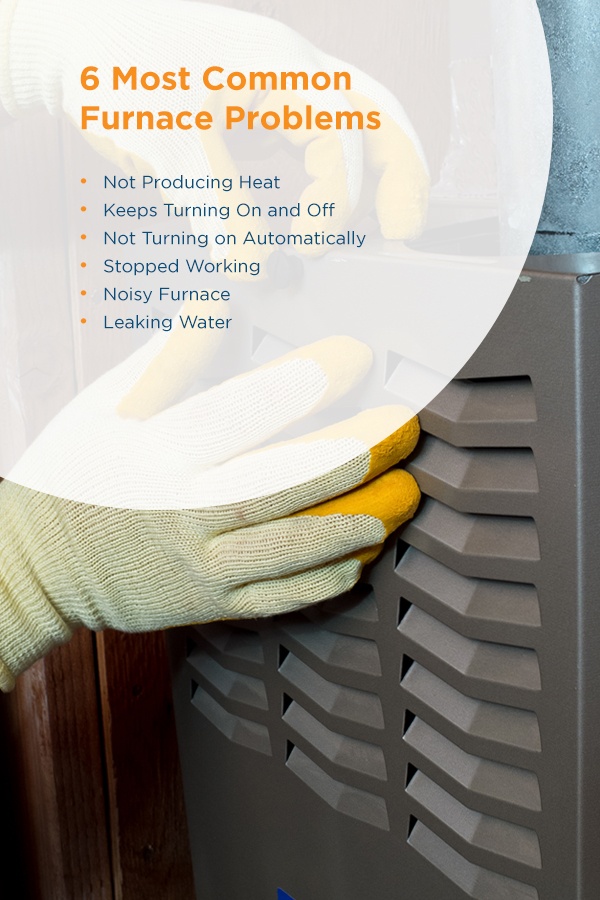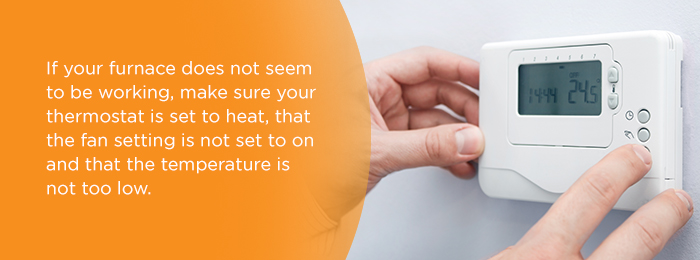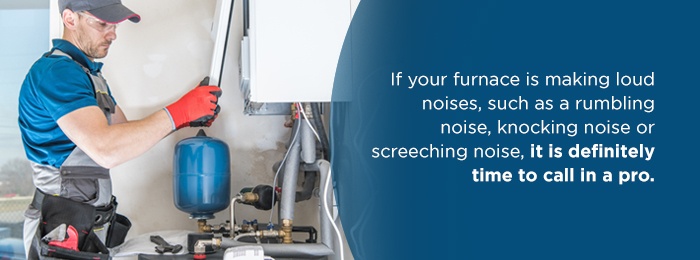6 Most Common Furnace Issues
When everything is going well with your home’s furnace, it is able to keep the temperature indoors at a comfortable, cozy level. You might not even notice it operating in the background when there are no issues. While your furnace is designed to have a long, useful life, there is a chance that something will go wrong with it. In a lot of instances, a furnace problem is relatively easy to fix. A trained technician can correct the problem quickly, or a homeowner might be able to do some troubleshooting on their own.
Understanding what some of the most common furnace problems in cold weather are can help you know what to look for and what to do to fix up your furnace.
6 Most Common Furnace Problems
Some furnace issues happen more often than others. In some cases, what seems to be a major problem with your furnace might actually be something that is easy to fix. Take a look at some of the most frequently-occurring furnace concerns. The most common furnace problems include:
- Not producing heat
- Keeps turning on and off
- Not turning on automatically
- Stopped working
- Noisy furnace
- Leaking water
1. Your Furnace Is Not Producing Heat
Your furnace really only has one job: to distribute warm air through your home, so that you and anyone else who lives there can be comfortable when it is cold outside. If a furnace is not producing heat, it is often a cause for alarm, but in many instances, it might not be that big of an issue. One of the reasons your furnace might be blowing air but not producing heat is if there is a fan setting on your thermostat. When the fan setting is turned on, the furnace will blow air through the home, but the air will not be warmed up.
Another reason your furnace might not produce heat is if the thermostat is not turned on or set to “heat,” or if the temperature setting on the thermostat is too low. If you are concerned about your furnace, one of the first things to do is take a look at the thermostat to make sure it is turned to the appropriate setting.
Your furnace’s air filter prevents dust and debris from traveling through the ducts and blowing into the rooms of your home. Ideally, you will replace the filter regularly, at least once during the winter season or monthly, if you have pets or a large family. When the filter does not get replaced often enough, it can become clogged. The buildup of dust and debris restricts the airflow from the furnace, making it seem as if the equipment is not producing any heat. Replacing the air filter might be enough to fix the issue.
One additional reason why a furnace might not produce heat is if there is no flame to ignite the fuel and warm the air. The pilot light in a furnace is responsible for igniting the fuel. Older models have a continuously lit pilot light, and there is a chance that the flame will go out. Newer furnaces often have electronic ignition, which ignites the pilot light when the furnace cycles on. If there is an issue with the ignition, the flame might not catch, and the furnace will not be able to produce warm air.

If you have ruled out a problem with the thermostat or air filter, the issue might be connected to the pilot light. In that case, your best option is to call in a technician to look at the furnace and make the appropriate repairs.
2. Your Furnace Keeps Turning on and Off
Lorem ipsum dolor sit amet, consectetur adipiscing elit. Ut elit tellus, luctus nec ullamcorper mattis, pulvinar dapibus leo.
As a furnace heats your home, it typically cycles on and off, trying to maintain the temperature set on the thermostat. Depending on the programmed temperature and the outdoor temperature, a furnace might cycle on, heat the room or home to the desired temperature, then cycle off again several times an hour.
If a furnace starts short cycling or turning on and off frequently, without ever reaching the set temperature, that is usually a sign that something is wrong. During a short cycle, the furnace will only run for a couple of minutes before it turns off again. Often, the cause of a short cycle is a lack of airflow in the furnace, which causes it to overheat. Furnaces have safety switches built-in that will shut down the system if the temperature gets too hot.
A clogged air filter can restrict airflow, leading to overheating and the safety switch going off. If you notice that your furnace is turning on and off frequently or is only running for a couple of minutes at time, never heating up to the desired temperature, your first step might be to check and replace the air filter. If replacing the air filter does not resolve the issue, you will need to call a technician to take a closer look.
3. Your Furnace Is Not Turning on Automatically
When everything is working as it should be, your furnace will switch on and produce heat once it gets the signal from the thermostat. But if you have noticed that it is not turning on and it is getting a bit chilly in your home, there might be something wrong. As with other furnace issues, the problem might be a quick fix or it might be a sign of a larger concern with the heating equipment.
For example, your furnace is not going to turn on if the circuit breaker is turned off. If the equipment is not working, take a look at the breaker box and try to flip the switch labeled “furnace.” That might be all you need to do to get things started again.
Another thing that might keep your furnace from turning on is the thermostat. If the temperature on the thermostat is too low, your furnace will not kick on until it registers that lower temperature. If your thermostat is set to “off” or “cool,” the furnace is not going to turn on. Take a look at the thermostat and adjust it as needed to see if doing so gets your furnace to work.
Other reasons your furnace might not turn on automatically include:
- Clogged air filter
- Faulty ignition or pilot light
- No fuel
4. Your Furnace Stopped Working
Your furnace has recently started a cycle when it suddenly shut down before the room reached the set temperature. As with other furnace problems, a furnace might stop working because it tripped the circuit breaker, there was an issue with the pilot light or ignition, airflow was restricted or some issue triggered a safety switch that shut down the system. If your furnace has shut down and you cannot figure out why, your best option is to call in a trained technician to take a look at it and diagnose the problem.
5. You Have a Noisy Furnace
Most furnaces make some noise as they operate. You might hear clicks when the thermostat reaches a certain temperature and sends a signal to the furnace, and you are likely to hear a “whooshing” noise as the air travels through your ductwork. The blower on some furnaces is louder than others.
But some noises can be a sign that something is up with your system and that the equipment needs to be inspected, repaired or potentially replaced. For example, if your furnace is making a knocking noise or the furnace is making a rattling noise, that could be a sign that something has come loose and needs to be tightened or adjusted. If your furnace is making a loud rumbling noise, there might be fuel left in the combustion chamber after the system has shut off. In either case, you will want to turn off your furnace and call in a technician to take a look at what is going on.
6. Your Furnace Is Leaking Water
Certain types of furnaces can develop condensation leaks, which cause water to pool around the base of the furnace. If you have a high-efficiency furnace with an annual fuel utilization efficiency (AFUE) rating over 90%, the furnace most likely has a cool exhaust feature. High-efficiency furnaces often have PVC exhaust pipes, rather than metal pipes. They also have condensation pipes, which route the water produced as the combustion fuel cools to a drain. If the condensation pipe becomes clogged or otherwise develops a leak, water can pool around the bottom of the furnace. If that happens, your best option is to call in a technician to investigate.
Troubleshooting Your Furnace Problems
Although there are instances when a furnace problem needs attention from an experienced technician, in some cases the problem might be something you can solve on your own. If your furnace is not turning on or is not producing enough heat, you can run through a few simple oil or gas furnace troubleshooting steps to see if it is an issue you can fix on your own:
- Check the circuit breaker: Your furnace needs electricity to operate. There are cases when the circuit breaker will have tripped, turning off power to the heating system. Take a look at your breaker box to see if the furnace’s breaker is flipped in the opposite direction of the other switches in the box. If so, try switching it back on. If it stays and the furnace powers up again, you should be fine. If the switch will not stay on, do not try to force it. Instead, call in a technician to take a look.

- Inspect the thermostat: The settings on your thermostat can have a big effect on its operation. If your furnace does not seem to be working, make sure your thermostat is set to heat, that the fan setting is not set to on, and that the temperature is not too low.
- Replace the air filter: A clogged filter will have a dramatic effect on your furnace’s operation. If it has been a while since you changed or inspected the filter, it might be a good idea to replace it with a new one.
- Check the vents and registers: Ideally, the vents and registers that send warmed air into each room of your home will stay open, even if you do not use a particular room all that often. Closing the registers can create problems with the furnace, along with keeping warm air from reaching the room. Depending on the location of the registers and vents, it can be easy for them to get closed by accident. If you do not feel warm air coming out while your furnace is running, look at each register and flip the switch on the side to open up the vents.
When to Call an HVAC Technician
Although checking the thermostat and circuit breaker are things you can do on your own to see if they correct the problem with your furnace, there might be times when the issue requires attention from a trained HVAC technician. If the power is on, the thermostat is functional and you have recently replaced the air filter, you might want to call and have a professional come out to take a look. It is not recommended to try and repair anything on or in your furnace yourself, as it could be very dangerous if you are not professionally trained to work on HVAC equipment.
If the furnace will not turn on, it could be because you are out of oil or propane gas. You can try to check the level of fuel in your oil or gas tank and call for delivery to refill the tank. After delivering the fuel, the technician can also get your system up and running again.

There are also instances when your safest option is to call in a professional to take a look at your furnace, rather than to try and fix it on your own. For example, if your furnace is making loud noises, such as a rumbling noise, knocking noise or screeching noise, it is definitely time to call in a pro. The same is true if your furnace is leaking water or if you suspect there is a problem with the ignition or pilot light.
You might also want to call in a technician to check things out if you notice strange smells coming from your furnace, too. If it smells like something is burning or like gasoline, you will want to have someone come take a look right away. If you smell something like rotten eggs, your best option is to leave your home as quickly as possible and call 911, especially if you have propane. Gas companies add a chemical to propane to create the distinct, sulfur-like scent of rotten eggs. If you smell it, there might be a gas leak. Stay out of your home until someone arrives to take a look and lets you know when it is safe to go back in.
Let SMO Energy Solve Your Furnace Troubles
Whether your furnace is making strange noises, producing weird smells, leaking or not working the way you expect it to
When in doubt about the state of your furnace, your best bet is to have someone come and take a look at it. SMO Energy has been serving residents of Southern Maryland since 1926. Our trained, NATE-certified technicians are available to inspect your furnace, diagnose any issues and recommend the most appropriate course of action, whether that means replacing your furnace or performing some of the most common furnace repairs, such as refilling the fuel. We can also work with you to help you choose new heating equipment to keep your home cozy and comfortable.
Whether your furnace is making strange noises, producing weird smells, leaking or not working the way you expect it to, contact us today. Someone will be out to take a look and help you decide what to do next.
